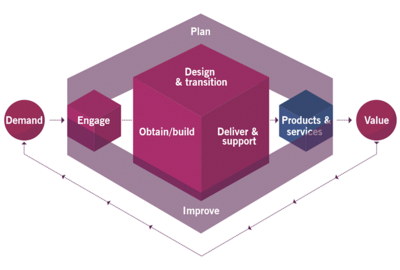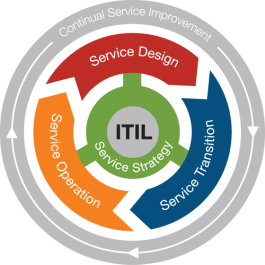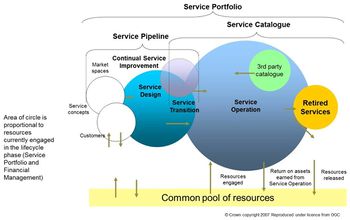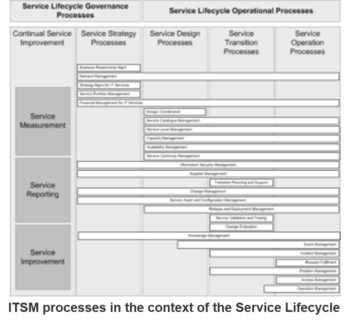ITIL Service Lifecycle
ITIL Service Lifecycle is a framework consisting of processes for effectively managing the service lifecycle of any product or service offered by an organization. Although it is an approach for IT Service Management (ITSM), it can be used by any organization irrespective of its size to manage the full lifecycle of not only the IT services but any service that it offers. Service lifecycle helps to improve the service management technique by using five processes to achieve better business performance.[1]
ITIL Service Lifecycle Stages[2]
The ITIL version 3 proposes the concept of service life cycle containing stages, each with different goals, as follows:
- Service Strategy - SS: to understand the company's strategy and define how IT services will meet the strategic objectives of the organization;
- Service Design - SD: to guide the design of IT services to ensure service quality, customer satisfaction and the cost-benefit relationship of the services provided;
- Service Transition - ST: to guide the development of resources for the creation of new services or services in IT operations and ensure that they meet the business needs according to the "strategy" and "design" of the services;
- Service Operation - SO: to provide guidance on how to achieve effectiveness and efficiency in the delivery and support of services, to ensure the value expected by the customer and meet the strategic goals of the company;
- Continual Service Improvement - CSI: to identify results and advise on the improvement of services by joining forces with the Strategy, Design, Transition and Operation Services phases in order to create and maintain the value of services.
The processes and functions proposed by the ITIL® V3 2011 edition for each stage of the service lifecycle, as shown in figure above, are:
- Service Strategy
- Strategy Management Process for IT Services
- Financial Management Process for IT Services
- Service Portfolio Management Process
- Demand Management Process and
- Management of the Relationship with the Business Process
- Service Design
- Design Coordination Process
- Service Catalog Management Process
- Service Level Management Process
- Capacity Management Process
- Availability Management Process
- Management of IT
- Service Continuity Process
- Supplier Management Process
- Service Transition
- Planning and Transition Support Process
- Change Management Process
- Configuration and Service Asset Management Process
- Knowledge Management Process
- Release and Deployment Management Process
- Validation and Service Testing Process
- Changes Evaluation Process
- Service Operation
- Event Management Process
- Incident Management Process
- Request Fulfillment Process
- Access Management Process
- Problem Management Process
- IT Service Desk Function
- Technical Management Function
- IT Operations Management Function
- Application Management Function
- Continual Improvement of Service
- Seven Steps to the Improvement Process
How to Revive the Service LifeCycle View[3]
When the Service Lifecycle concept was introduced to the ITIL framework some years ago, the IT Service Management community took a big step forward: ITIL Best Practice turned from a rather isolated process-driven view (ITIL V2) into a more holistic, service lifecycle-oriented approach (ITIL V3), something that didn’t fundamentally change in the 2011 edition. In a nutshell, it’s simple as that: IT services, delivering value to clients, pass through a lifecycle from service structuring, design, transition, operations (where the service is delivered to the client) and finally continual optimization. The role of ITSM processes is to support the Service Lifecycle. Just to give you a practical example: Change Management, which supports mainly the Service Transition Lifecycle, makes sure that Changes to Services are introduced into Operations in a controlled manner and with minimal risk.
The following key points will help you to ‘revive’ the Service Lifecycle view
1. The Service Portfolio is the “backbone” of the Service Lifecycle
Service Portfolio Management and later on Service Catalog Management are excellent methods to govern your services throughout the Service Lifecycle. The Service Portfolio ensures that you as an IT Service Provider Organization have the right mix of services to meet required business outcomes at an appropriate level of investment. Once these services are in the transition and service operation phase (visible to the client), they are maintained as part of the service catalogue, containing detailed service information. One really useful thing to remember is that whatever ITSM process you are discussing in your organization, you always can refer back to the service portfolio and catalog to make sure, that you are still oriented towards the IT services that has to be delivered to your client.
2. Look at ITSM processes from a Service Lifecycle perspective
ITSM processes support the Service Lifecycle. This means that you should always bring an ITSM process into the context of the Service Lifecycle. For Example: The purpose of Event Management, as described in the books, is to detect events, make sense of them and determine the appropriate control actions. This first looks like a pure Service Operation issue (this is also the way it is described in the Service Operations book). However, if you think about it from a lifecycle view, suddenly service design comes into play, because event rule sets first need to be designed in order to enable the detection of events in a meaningful way and these rule sets need to be orientated towards the services you deliver – which makes the connection to the service catalog mentioned earlier.
3. ITSM processes are not limited to one Service LifeCycle
With the example mentioned earlier it also becomes clear that an ITSM process usually does not belong only to one Service Lifecycle as commonly understood. Probably the reason for this misunderstanding is due to the way the human brains works (knowledge needs to be hierarchical) and the fact that each of the processes is described in one of the Service Lifecycle books (everything else would have been difficult). The graph shown above illustrates the connection between processes and lifecycle very well.
4. Implement Continual Service Improvement
One additional way to revive the Service Lifecycle view is to implement Continual Service Improvement (CSI) in your IT Service Provider Organization. CSI as a discipline spans over all other Service Lifecycles and makes sure that Services are aligned and realigned towards changed business requirements by implementing improvement actions. CSI reviews and analyzes each lifecycle and makes recommendations to either improve the service quality or to increase the cost efficiency.
How ITIL 4 changed the ITIL service lifecycle[4]
The quick answer to what happened to the service lifecycle in ITIL 4 is that it disappeared completely when the ITIL 4 Foundation publication came out in February 2019. The ITIL 4 approach and best practice guidance is now built around the service value system and service value chain:

source: AXELOS, ITIL Foundation ITIL 4 Edition (2019)
The service lifecycle isn’t dead (or consigned to history): it can still help service organizations. If you want to continue to use the service lifecycle approach, you have three options:
1. Simply continue to use the ITIL v3 guidance – and ignore ITIL 4.
This is basically the “do nothing” option. If ITIL v3 is working for your organization, you might think that an “if it ain’t broke, don’t fix it” approach will work for you. And yes, it’ll definitely save your organization from the necessary investment in the ITIL 4 approach and the associated disruption caused by the various changes to the status quo. On the other hand, there are a number of good reasons why ITIL v3 needed to be updated, including the impact of the changes in the technologies that need to be managed and the expectations of organizations. If you go for option 1, your organization won’t benefit from the new ITIL best practices that address these and other ITSM ecosystem and business changes. As you’ll see later, option 3 is more appropriate if you want to hold on to the service lifecycle.
2.Replicate the ITIL service lifecycle using the ITIL 4 service value chain.
Options two and three are very similar. In both options, you continue to use the ITIL v3 service lifecycle along with the newer ITIL 4 best practices across the 34 ITIL management practices. The difference is that option two uses the ITIL 4 service value chain approach, which recognizes that the ITIL v3 service lifecycle stems from a time when IT used a waterfall approach to change. In contrast, ITIL 4’s new value stream approach is fit for both waterfall and iterative methodologies. So how can you replicate the service lifecycle using the service value chain? Use the various value chain activities as follows:
- Engage – starting with what was service strategy in ITIL v3: finding out what’s needed (demand);
- Plan – elements of service strategy and service design;
- Design & Transition – service design;
- Obtain/Build – elements of service design and service transition;
- Design & Transition – service transition;
- Deliver & Support – service operation (including value creation);
- Improve – with what was continual service improvement (CSI), hopefully happening throughout.
Realistically though, if your organization wants to use the service value chain, you’re more likely to fully adopt the concept rather than a hybrid of old and new approaches. That’s why option three is a more likely option if you want to continue to use the service lifecycle.
3. View the ITIL 4 guidance through an ITIL service lifecycle lens.
In other words: continue to use the ITIL service lifecycle while adopting the newer ITIL 4 practices over the ITIL v3 processes. There are many benefits in choosing this option over the previous two.
- Firstly, this option involves adopting the latest service management best practice from the many ITIL authors who help organizations improve their service delivery and support. ITIL 4 has many improvements compared to ITIL v3, including the laser focus on value creation (or co-creation), the elevation of capability-based thinking from processes to practices and additional practices such as IT asset management, the inclusion of the ITIL guiding principles that were introduced in 2016’s ITIL Practitioner Guidance publication, and the change from CSI to continual improvement that recognizes that you need to improve more than just services.
- Secondly, the ITIL v3 service lifecycle can easily be understood and used by organizations, for example as the model for creating new or changed services. Here, the service lifecycle makes it easier to explain what’s needed to create new services or change or improve existing services.
- Thirdly, the ITIL service lifecycle is a much more convenient way to group the 26 processes and four functions of ITIL v3 compared to the three less descriptive groupings of ITIL 4’s 34 management practices: general management practices, service management practices, and technology management practices.
So, what does the loss of the ITIL service lifecycle mean for you? It depends on how you and your organization view the value of the service lifecycle.
- If the service lifecycle is a vital part of ITIL adoption and use for you and your organization, there’s likely value in continuing to use it, ideally via option three. Which option you choose will likely depend on your organization’s affinity with the service value chain and the creation of value streams in ITIL 4 though.
- If the service lifecycle isn’t vital to your organization though, you should adopt ITIL 4’s service value system and service value chain. Instead of creating new or changed IT services using the service lifecycle, the service value chain will provide the platform for service creation. Starting from demand on the left, working through to value on the right. This includes the creation of IT’s own capabilities and not just the services offered to customers.
- For many people though, the service lifecycle makes it easier to understand the spectrum of ITIL guidance. So, if you want to continue to use the service lifecycle and its stages to better understand the different types of ITIL 4 practices, why not? Ultimately, ITIL is about “adopting and adapting.” Use the ITIL service lifecycle as best fits your organization’s needs – this may include continuing to use the service lifecycle to better understand the ITIL 4 practices.
See Also
References
- ↑ Definition - What Does ITIL service Library Mean? EduCBA
- ↑ The Goals, Processess and Functions of the ITIL Service Lifecycle Stages Carolina Ferreira, Andrea Nery,Placido Rogerio Pinheiroa
- ↑ How to revive the Service Lifecycle Blog.ITIL.Org
- ↑ How ITIL 4 changed the ITIL service lifecycle Stephen Mann



